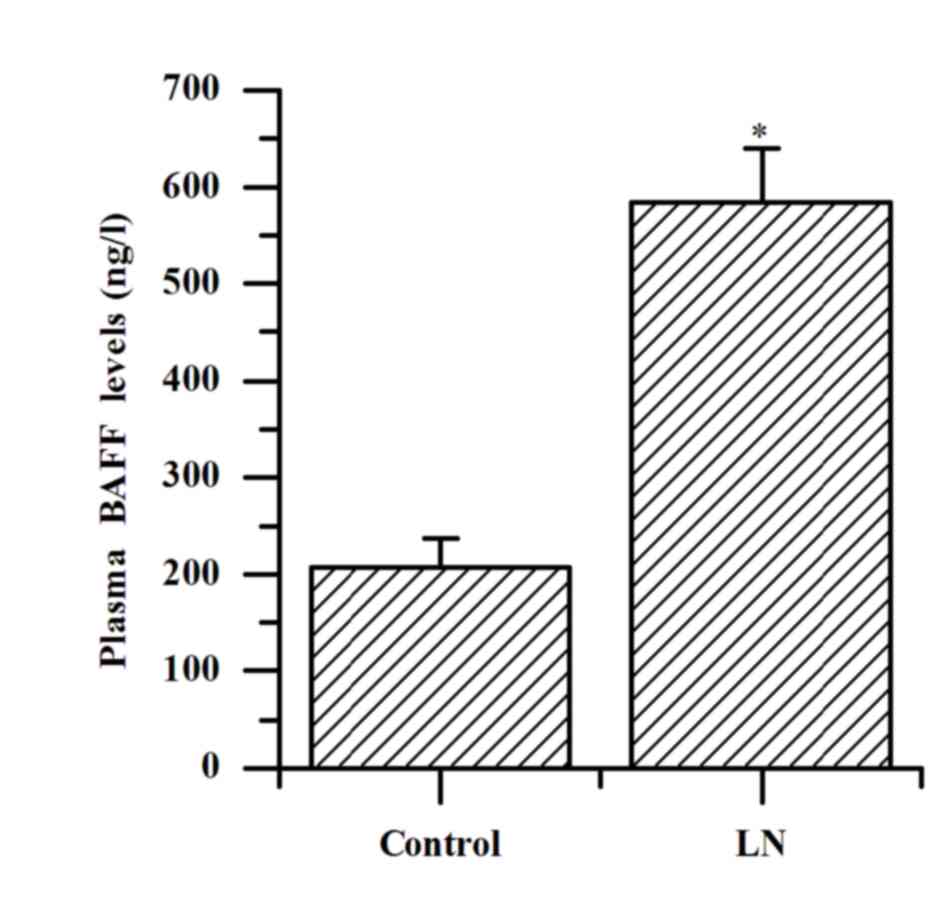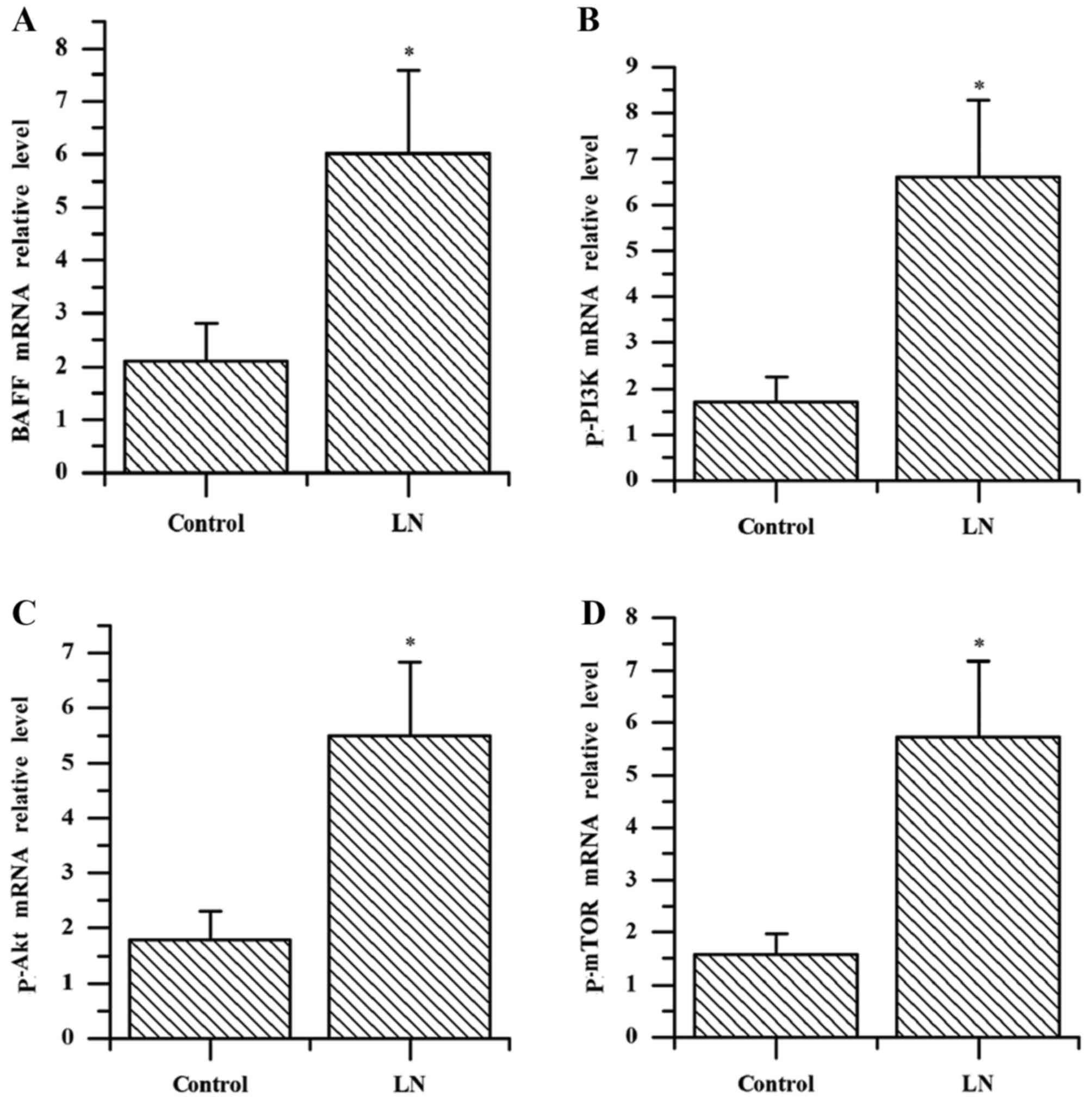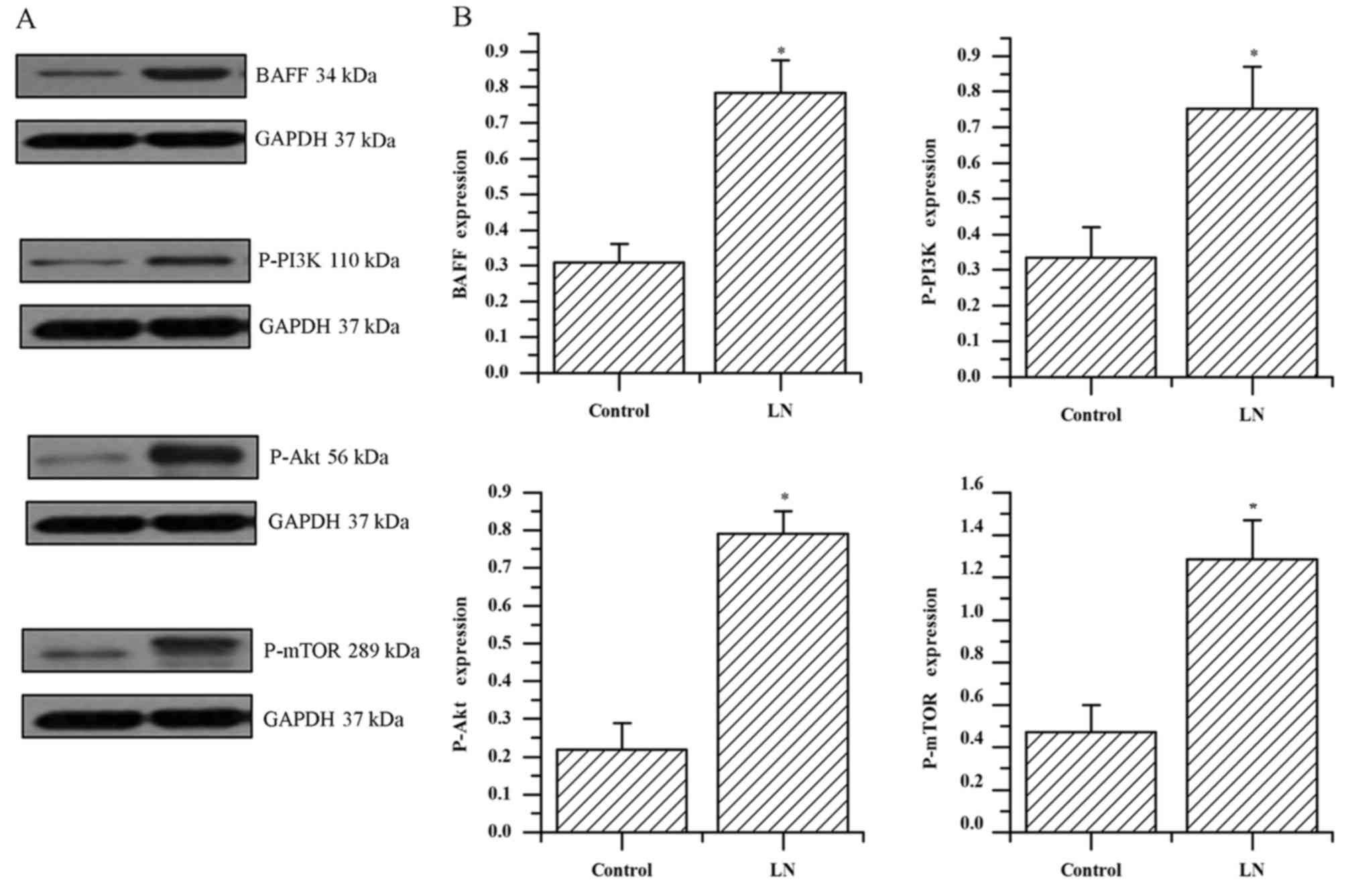|
1
|
Crispín JC, Kyttaris VC, Terhorst C and
Tsokos GC: T cells as therapeutic targets in SLE. Nat Rev
Rheumatol. 6:317–325. 2010. View Article : Google Scholar : PubMed/NCBI
|
|
2
|
De Zubiria Salgado A and Herrera-Diaz C:
Lupus nephritis: An overview of recent findings. Autoimmune Dis.
2012:8496842012.PubMed/NCBI
|
|
3
|
Tsokos GC: Systemic lupus erythematosus. N
Engl J Med. 365:2110–2121. 2011. View Article : Google Scholar : PubMed/NCBI
|
|
4
|
Shen Y, Sun CY, Wu FX, Chen Y, Dai M, Yan
YC and Yang CD: Association of intrarenal B-cell infiltrates with
clinical outcome in lupus nephritis: A study of 192 cases. Clin Dev
Immunol. 2012:9675842012. View Article : Google Scholar : PubMed/NCBI
|
|
5
|
Sun CY, Shen Y, Chen XW, Yan YC, Wu FX,
Dai M, Li T and Yang CD: The characteristics and significance of
locally infiltrating B cells in lupus nephritis and their
association with local BAFF expression. Int J Rheumatol.
2013:9542922013. View Article : Google Scholar : PubMed/NCBI
|
|
6
|
Heinemann K, Wilde B, Hoerning A, Tebbe B,
Kribben A, Witzke O and Dolff S: Decreased IL-10(+) regulatory B
cells (Bregs) in lupus nephritis patients. Scand J Rheumatol.
45:312–316. 2016. View Article : Google Scholar : PubMed/NCBI
|
|
7
|
Schneider P and Tschopp J: BAFF and the
regulation of B cell survival. Immunol Lett. 88:57–62. 2003.
View Article : Google Scholar : PubMed/NCBI
|
|
8
|
Mackay F and Browning JL: BAFF: A
fundamental survival factor for B cell. Nat Rev Immunol. 2:465–475.
2002. View
Article : Google Scholar : PubMed/NCBI
|
|
9
|
Schneider P, MacKay F, Steiner V, Hofmann
K, Bodmer JL, Holler N, Ambrose C, Lawton P, Bixler S and
Acha-Orbea H: BAFF, a novel ligand of the tumor necrosis factor
family, stimulates B cell growth. J Exp Med. 189:1747–1756. 1999.
View Article : Google Scholar : PubMed/NCBI
|
|
10
|
Mayne CG, Amanna IJ, Nashold FE and Hayes
CE: Systemic autoimmunity in BAFF-R-mutant A/WySnJ strain mice. Eur
J Immunol. 38:587–598. 2008. View Article : Google Scholar : PubMed/NCBI
|
|
11
|
Mackay F and Schneider P: Cracking the
BAFF code. Nat Rev Immunol. 9:491–502. 2009. View Article : Google Scholar : PubMed/NCBI
|
|
12
|
Thien M, Phan TG, Gardam S, Amesbury M,
Basten A, Mackay F and Brink R: Excess BAFF rescues self-reactive B
cells from peripheral deletion and allows them to enter forbidden
follicular and marginal zone niches. Immunity. 20:785–798. 2004.
View Article : Google Scholar : PubMed/NCBI
|
|
13
|
Gross JA, Johnston J, Mudri S, Enselman R,
Dillon SR, Madden K, Xu W, Parrish-Novak J, Foster D and Lofton-Day
C: TACI and BCMA are receptors for a TNF homologue implicated in
B-cell autoimmune disease. Nature. 404:995–999. 2000. View Article : Google Scholar : PubMed/NCBI
|
|
14
|
Khare SD, Sarosi I, Xia XZ, McCabe S,
Miner K, Solovyev I, Hawkins N, Kelley M, Chang D and Van G: Severe
B cell hyperplasia and autoimmune disease in TALL-1 transgenic
mice. Proc Natl Acad Sci USA. 97:3370–3375. 2000; View Article : Google Scholar : PubMed/NCBI
|
|
15
|
Moore PA, Belvedere O, Orr A, Pieri K,
LaFleur DW, Feng P, Soppet D, Charters M, Gentz R and Parmelee D:
BLyS: Member of the tumor necrosis factor family and B lymphocyte
stimulator. Science. 285:260–263. 1999. View Article : Google Scholar : PubMed/NCBI
|
|
16
|
Henley T, Kovesdi D and Turner M: B-cell
responses to B-cell activation factor of the TNF family (BAFF) are
impaired in the absence of PI3K delta. Eur J Immunol. 38:3543–3548.
2008. View Article : Google Scholar : PubMed/NCBI
|
|
17
|
Shor B, Cavender D and Harris C: A
kinase-dead knock-in mutation in mTOR leads to early embryonic
lethality and is dispensable for the immune system in heterozygous
mice. BMC Immunol. 10:282009. View Article : Google Scholar : PubMed/NCBI
|
|
18
|
Fruman DA: Phosphoinositide 3-kinase and
its targets in B-cell and T-cell signaling. Curr Opin Immunol.
16:314–320. 2004. View Article : Google Scholar : PubMed/NCBI
|
|
19
|
Li PP, Liu DD, Liu YJ, Song SS, Wang QT,
Chang Y, Wu YJ, Chen JY, Zhao WD, Zhang LL and Wei W: BAFF/BAFF-R
involved in antibodies production of rats with collagen-induced
arthritis via PI3K-Akt-mTOR signaling and the regulation of
paeoniflorin. J Ethnopharmacol. 141:290–300. 2012. View Article : Google Scholar : PubMed/NCBI
|
|
20
|
Liu D, Li P, Song S, Liu Y, Wang Q, Chang
Y, Wu Y, Chen J, Zhao W, Zhang L and Wei W: Pro-apoptotic effect of
epigallo-catechin-3-gallate on B lymphocytes through regulating
BAFF/PI3K/Akt/mTOR signaling in rats with collagen-induced
arthritis. Eur J Pharmacol. 690:214–225. 2012. View Article : Google Scholar : PubMed/NCBI
|
|
21
|
Livak KJ and Schmittgen TD: Analysis of
relative gene expression data using real-time quantitative PCR and
the 2(-Delta Delta C(T)) method. Methods. 25:402–408. 2001.
View Article : Google Scholar : PubMed/NCBI
|
|
22
|
Vincent FB, Morand EF, Schneider P and
Mackay F: The BAFF/APRIL system in SLE pathogenesis. Nat Rev
Rheumatol. 10:365–373. 2014. View Article : Google Scholar : PubMed/NCBI
|
|
23
|
Salazar-Camarena DC, Ortiz-Lazareno PC,
Cruz A, Oregon-Romero E, Machado-Contreras JR, Muñoz-Valle JF,
Orozco-López M, Marín-Rosales M and Palafox-Sánchez CA: Association
of BAFF APRIL serum levels, BAFF-R, TACI and BCMA expression on
peripheral B-cell subsets with clinical manifestations in systemic
lupus erythematosus. Lupus. 25:582–592. 2016. View Article : Google Scholar : PubMed/NCBI
|
|
24
|
Figgett WA, Deliyanti D, Fairfax KA, Quah
PS, Wilkinson-Berka JL and Mackay F: Deleting the BAFF receptor
TACI protects against systemic lupus erythematosus without
extensive reduction of B cell numbers. J Autoimmun. 61:9–16. 2015.
View Article : Google Scholar : PubMed/NCBI
|
|
25
|
Jordan N and D'Cruz DP: Belimumab for the
treatment of systemic lupus erythematosus. Expert Rev Clin Immunol.
11:195–204. 2015. View Article : Google Scholar : PubMed/NCBI
|
|
26
|
Debnath I, Roundy KM, Weis JJ and Weis JH:
Analysis of the regulatory role of BAFF in controlling the
expression of CD21 and CD23. Mol Immunol. 44:2388–2399. 2007.
View Article : Google Scholar : PubMed/NCBI
|
|
27
|
Woodland RT, Fox CJ, Schmidt MR, Hammerman
PS, Opferman JT, Korsmeyer SJ, Hilbert DM and Thompson CB: Multiple
signaling pathways promote B lymphocyte stimulator dependent B-cell
growth and survival. Blood. 111:750–760. 2008. View Article : Google Scholar : PubMed/NCBI
|
|
28
|
Patke A, Mecklenbräuker I,
Erdjument-Bromage H, Tempst P and Tarakhovsky A: BAFF controls B
cell metabolic fitness through a PKC beta- and Akt-dependent
mechanism. J Exp Med. 203:2551–2562. 2006. View Article : Google Scholar : PubMed/NCBI
|
|
29
|
Blachly JS and Baiocchi RA: Targeting
PI3-kinase (PI3K), AKT and mTOR axis in lymphoma. Br J Haematol.
167:19–32. 2014. View Article : Google Scholar : PubMed/NCBI
|
|
30
|
Laplante M and Sabatini DM: mTOR signaling
in growth control and disease. Cell. 149:274–293. 2012. View Article : Google Scholar : PubMed/NCBI
|
|
31
|
Shimobayashi M and Hall MN: Making new
contacts: The mTOR network in metabolism and signalling crosstalk.
Nat Rev Mol Cell Biol. 15:155–162. 2014. View Article : Google Scholar : PubMed/NCBI
|
|
32
|
Thomson AW, Turnquist HR and Raimondi G:
Immunoregulatory functions of mTOR inhibition. Nat Rev Immunol.
9:324–337. 2009. View
Article : Google Scholar : PubMed/NCBI
|
|
33
|
Wei LQ, Liang YG, Zhao Y, Liang HT, Qin DC
and She MC: Efficacy and safety of belimumab plus standard therapy
in patients with systemic lupus erythematosus: A meta-analysis.
Clin Ther. 38:1134–1140. 2016. View Article : Google Scholar : PubMed/NCBI
|
|
34
|
Asati V, Mahapatra DK and Bharti SK:
PI3K/Akt/mTOR and Ras/Raf/MEK/ERK signaling pathways inhibitors as
anticancer agents: Structural and pharmacological perspectives. Eur
J Med Chem. 109:314–341. 2016. View Article : Google Scholar : PubMed/NCBI
|
|
35
|
Lee JJ, Loh K and Yap YS: PI3K/Akt/mTOR
inhibitors in breast cancer. Cancer Biol Med. 12:342–354.
2015.PubMed/NCBI
|
|
36
|
Soares HP, Ming M, Mellon M, Young SH, Han
L, Sinnet-Smith J and Rozengurt E: Dual PI3K/mTOR inhibitors induce
rapid overactivation of the MEK/ERK pathway in human pancreatic
cancer cells through suppression of mTORC2. Mol Cancer Ther.
14:1014–1023. 2015. View Article : Google Scholar : PubMed/NCBI
|












